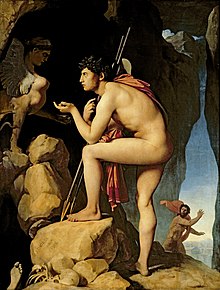Oedipus and the Sphinx
| Oedipus and the Sphinx | |
|---|---|
 | |
| Artist | Gustave Moreau |
| Year | 1864 |
| Medium | oil paint, canvas |
| Dimensions | 206 cm (81 in) × 105 cm (41 in) |
| Location | Metropolitan Museum of Art |
| Identifiers | The Met object ID: 437153 |



Oedipus and the Sphinx is an 1864 oil on canvas painting by Gustave Moreau that was first exhibited at the French Salon of 1864 where it was an immediate success. It is now in the Metropolitan Museum of Art. The work was a fresh treatment of the established subject of the meeting between Oedipus and the Sphinx on the road outside Thebes, as described in Sophocles's play Oedipus Rex.
Subject matter
The painting depicts Oedipus meeting the Sphinx at the crossroads on his journey between Thebes and Delphi. Oedipus must answer the Sphinx's riddle correctly in order to pass. Failure means his own death and that of the besieged Thebans. The riddle was: "What walks on four feet in the morning, two in the afternoon and three at night?". Oedipus answered: "Man: as an infant, he crawls on all fours; as an adult, he walks on two legs and; in old age, he uses a walking stick". Oedipus was the first to answer the riddle correctly and, having heard Oedipus' answer, the Sphinx was astounded and inexplicably killed herself by throwing herself into the sea. Oedipus thereby won the freedom of the Thebans, the kingdom of that city, and as his wife, Jocasta, who was later revealed to be his mother.
Style and antecedents
In this work Moreau deliberately rejects the
Unlike Ingres' version where Oedipus appears as the dominant figure with the Sphinx on the defensive and partly obscured, in Moreau's version the Sphinx is on the offensive, clawing at Oedipus whose victory in the encounter does not yet seem assured. Indeed, other works by Moreau often feature victorious sphinxes atop a mound of victims.[3]
The Sphinx in the painting may be seen as a form of
By contrast,
The intense gaze shared between the two has been seen as characteristic of Moreau "who again and again suggests an ambiguous mirror-image, two aspects, two abstract entities that confront each other and recognize each other all too well".[6]
Reception
The painting was an immediate success at the Salon.[1] E. de Sault wrote in the Temps of Moreau's "devotion to the old masters, and the knowledge and application of sound principles and traditions. The painter of Oedipus, obscure and unknown yesterday, and who will be famous tomorrow".[7] It rescued what was otherwise seen as a mediocre show. One critic commented, "Mr. Gustave Moreau is the hero of this Exhibition and the grumblers proclaim that if the Salon of 1864 is retrieved from discredit, it is thanks to Oedipus and the Sphinx".[8]
The only serious criticism levelled at the work was that its figures might have been too inspired by the work of Mantegna. Critic
Another critic observed that a Greek sphinx, half-woman and half-vulture, was shown, rather than an Egyptian seated sphinx, but felt that whereas Ingres had presented a modern Oedipus, Moreau had better interpreted the classical Oedipus.[10]
After the Salon, Moreau quickly gained a reputation for eccentricity. One commentator said Moreau's work was "like a pastiche of Mantegna created by a German student who relaxes from his painting by reading
History
The painting was first sold by the artist in 1864 to
On his death, Moreau left all of his extant paintings to the French nation where they formed the basis for the subsequent
References
- ^ a b c d e Gustave Moreau: Oedipus and the Sphinx. Heilbrunn Timeline of Art History, Metropolitan Museum of Art, 2014. Retrieved 30 June 2014.
- ^ Oedipus and the Sphinx The National Gallery, 2014. Retrieved 30 June 2014.
- ^ ISBN 0500090831
- ^ Cole, Brendan (1993). The Mythic Feminine in Symbolist Art: Idealism and Mysticism in Fin-de-Siecle Painting (Thesis). University of Cape Town. pp. 45–49, 100–110. Retrieved 6 June 2021.
- ^ Dorra, Henri. "The Guesser Guessed: Gustave Moreau's Œdipus." Gazette des beaux-arts, 81 (March 1973), pp. 129–140.
- ^ Ashton, Dore. (1961) Odilon Redon, Gustave Moreau, Rodolphe Bresdin. Exh. cat. New York: Museum of Modern Art, pp. 113, 115, 179, no. 175, ill.
- ^ ISBN 0500090831
- ^ ISBN 0714817333
- ^ "Salon de 1864: Le salon des refusés." L'Artiste, 2 (30 June 1864), p. 4.
- ^ "Old Noll". "Des tendances de l'art contemporain, à l'occasion de l'Exposition des beaux-arts de 1864." Annales de la charité (Revue d'économie chrétienne) 6 (May 1864), pp. 883–902.
- ISBN 0500201250
- ^ Oedipus and the Sphinx Metropolitan Museum of Art, 2014. Retrieved 26 June 2014.
- ^ a b Tinterow, Gary. Compiled with Susan Alyson Stein & Barbara Burn. (1993). The New Nineteenth-Century European Paintings and Sculpture Galleries. New York: Metropolitan Museum of Art. p. 49.
External links
 Media related to Oedipus and the Sphinx by Gustave Moreau at Wikimedia Commons
Media related to Oedipus and the Sphinx by Gustave Moreau at Wikimedia Commons
